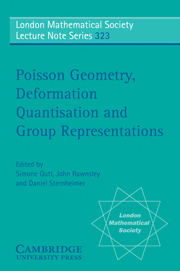Book contents
- Frontmatter
- Contents
- Preface
- Part One Poisson geometry and morita equivalence
- Part Two Formality and star products
- Part Three Lie groupoids, sheaves and cohomology
- Part Four Geometric methods in representation theory
- Part Five Deformation theory: a powerful tool in physics modelling
- 1 Introduction
- 2 Composite elementary particles in AdS microworld
- 3 Nonlinear covariant field equations
- 4 Quantisation is a deformation
- Bibliography
- Index
2 - Composite elementary particles in AdS microworld
Published online by Cambridge University Press: 04 August 2010
- Frontmatter
- Contents
- Preface
- Part One Poisson geometry and morita equivalence
- Part Two Formality and star products
- Part Three Lie groupoids, sheaves and cohomology
- Part Four Geometric methods in representation theory
- Part Five Deformation theory: a powerful tool in physics modelling
- 1 Introduction
- 2 Composite elementary particles in AdS microworld
- 3 Nonlinear covariant field equations
- 4 Quantisation is a deformation
- Bibliography
- Index
Summary
It follows from our deformation philosophy that, in order to anticipate new formalisms, we have to study deformations of the algebraic structures attached to a given formalism – and of course their representations, essential in physical applications. The only question is, in which category do we perform this search for deformations. Usually physics is rather conservative and if we start e.g. with the category of associative or Lie algebras, we tend to deform in this category. In the passage from Galilean physics to special relativity (new parameter c−1, where c is the speed of light), we deform the symmetry of the theory. In the Lie group (or algebra) category, there is a further deformation, giving rise to physics in (anti) de Sitter space-time (the new parameter being the curvature). It is this last aspect which we shall present here.
Recent experimental data indicate that the cosmological constant is most likely positive, suggesting (assuming a space-time of constant curvature, at least in first approximation) a de Sitter universe at cosmological distances. At our level, for (almost) all practical purposes, spacetime is Minkowskian (flat). We shall assume that, at a much smaller scale, a tiny constant negative curvature is present, i.e. an anti de Sitter (AdS) microworld. This Ansatz might be a consequence of the hidden presence, at that level, of compactified extra dimensions and should be related with ‘t Hooft ideas on holography [43], ideas that go beyond the AdS/CFT Maldacena conjecture [52].
- Type
- Chapter
- Information
- Publisher: Cambridge University PressPrint publication year: 2005

